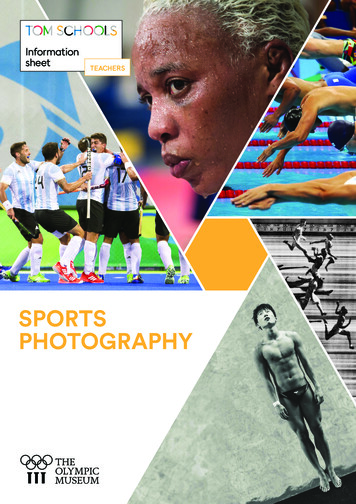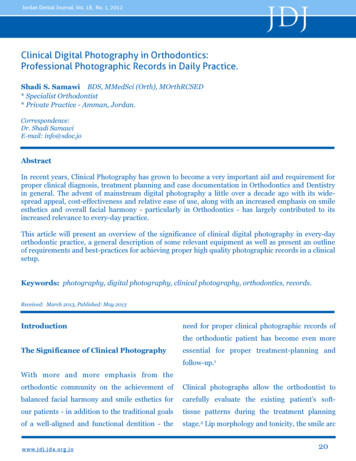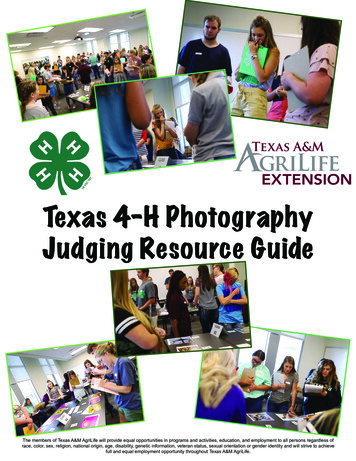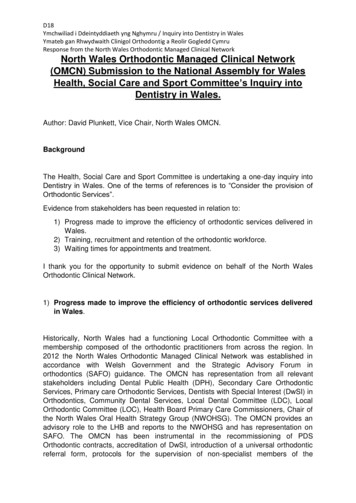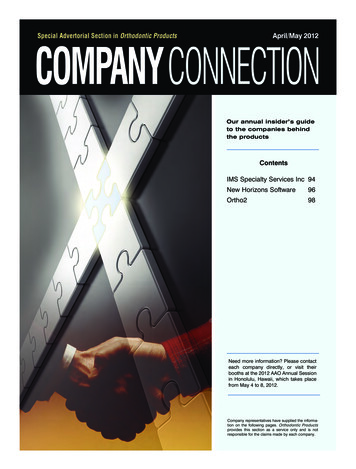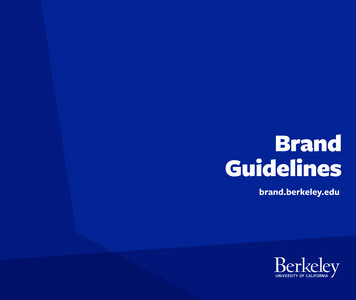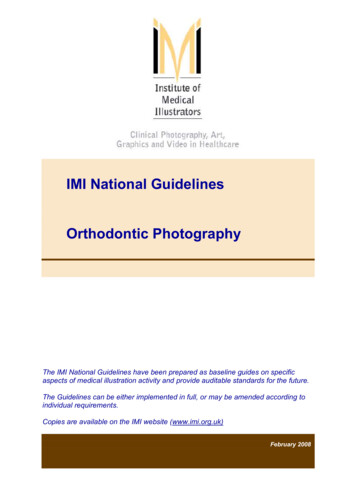
Transcription
IMI National GuidelinesOrthodontic PhotographyThe IMI National Guidelines have been prepared as baseline guides on specificaspects of medical illustration activity and provide auditable standards for the future.The Guidelines can be either implemented in full, or may be amended according toindividual requirements.Copies are available on the IMI website (www.imi.org.uk)February 2008
ContentsIntroduction - p3Health & Safety - p3Equipment - p4CamerasLightingRetractors and MirrorsBasic Dental Notation and Anatomy - p6Palmer’s Dental Notation for AdultsPalmer’s Dental Notation for ChildrenStandards for Extra-Oral Photography - p11BackgroundLightingMagnificationPatient positioning – for all viewsPatient positioning – for specific viewsAnterior PosteriorAnterior Posterior SmilingFace Right and Left Lateral views.Face Right and Left Oblique viewsStandards for Intra Oral Photography - p15GeneralAlignmentUse of RetractorsUse of mirrorsMagnificationProblems with salivaAnterior ViewRight and Left BuccalUpper OcclusalLower OcclusalOverjetClose up SmileStandard Orthodontic Views - p25Optional Orthodontic Views - p26AcknowledgementsIMI National GuidelinesOrthodontic PhotographyFebruary 20082
IntroductionAs with many aspects of clinical photography, the main purpose of dentalphotography is to help the dentist or clinician monitor and document the patient’streatment.Standardisation is paramount to maintain high quality clinical photography. Thisguide will help the photographer to produce the level of consistency needed to keepan accurate clinical record.At the end of these Guidelines there is a standard and optional set of views fororthodontic treatment.It is recommended that individual Medical Illustration Departments work withdentists/clinicians and use the ‘Standard Orthodontic View’ set and in addition, ifapplicable, selected views from the optional orthodontic view set, taking advice fromthese guidelines to produce a local protocol.Health & SafetyEach department/area should follow their local health and safety/infection controlpolicy.The following list provides examples of when it is advisable for hands to bedecontaminated either by using alcohol gel or washed with soap and warm water. Itis important to note that alcohol gel can irritate skin, so it is recommended that handsshould be washed throughout the day when using the gel. When washing hands, it isrecommended that soap is applied to wet hands. This reduces the likelihood of skinbeing irritated and damaged. Hands to be washed and clean at the start of the dayBefore wearing glovesBefore handling clinical equipmentBefore entering and leaving ward/clinical areaAfter removing glovesAfter decontamination of equipment/environmentAfter any situation that involves patient contactAfter handling clinical equipmentIt is good practice to use gloves when taking the intra-oral photographs. It isadvisable that both the photographer and any assistant wear gloves. This willsignificantly reduce the risks of cross infection between photographer and patient.All clinical equipment, i.e. cheek retractors and mirrors, should be cleaned by thecentral sterilisation department. It is recommended that such equipment be sterilisedas soon as possible after use.IMI National GuidelinesOrthodontic PhotographyFebruary 20083
EquipmentCamerasFor all routine dental photography, all camera equipment in this guide is basedaround a full sensor CCD, together with a macro lens with a focal length ofaround 100mm.This combination will ensure the correct perspective, as well as a convenient workingdistance, is maintained for both the facial and intra-oral views. It is essential that thelens be capable of producing magnifications of up to 1:1. For optimum depth of field,the lens must have a minimum working aperture of at least f22.LightingStudio electronic flash is recommended for photographing a patient’s facial and headand neck views. Output with either reflectors or umbrellas should be capable ofproducing sufficient light for an aperture of at least f16. Ideally, lights should besuspended on a Hi-glide system to allow ease of use and a safe workingenvironment for photographer and patient.Intra-oral photography requires the use of a portable electronic flash unit. For mostpurposes, a specialised ring flash provides even lighting and with some units, adegree of modelling can be achieved by positioning the flash unit.It is best that the ring flash is attached firmly to the camera lens, providing ease ofuse and standardised illumination. The ring-flash must be capable of producingsufficient light for an aperture of at least f22 to maximise depth of field.Retractors and MirrorsA range of mirrors and retractors are required to cope with the variety of dentitions,patient’s age, size of mouth and shape of the lips.Mirrors (see Figure 1) are available in either stainless steel or surface coated glass.Glass mirrors are preferable for higher reflectance and are available in a wide rangeof shapes. A standard set of mirrors should include palatal for both adults andchildren.Palatal mirrors are necessary for photographing the palate and maxillary views of thedental arch. Mirrors must be able to be autoclaved.Retractors are most commonly plastic and come in pairs. It is important that thedesign ensures excellent retraction of the lips and mucosa, pulling them away fromthe gums and teeth, to avoid the lips obscuring the teeth.IMI National GuidelinesOrthodontic PhotographyFebruary 20084
Figure 1 Selection of dental photography mirrorsIMI National GuidelinesOrthodontic PhotographyFebruary 20085
Basic Dental Notation and AnatomyBuccal – relating to the cheek, or the surface of the teeth facing toward the cheek.Buccal Mucosa – the mucous membrane of the inner cheekGingiva – the gumsLingual – relating to the tongue, or the surface of the teeth facing toward the tongue.Labial - the surface of the teeth adjacent to the lipsMaxilla – the upper jawMandible – the lower jawOcclusal – the biting surface of the teethOcclusion – both sets of teeth biting togetherPalatal – relating to the roof of the mouth, or the surface of the teeth nearest to thepalate.IMI National GuidelinesOrthodontic PhotographyFebruary 20086
Palmer’s Dental Notation for Adults (see Figures 2 & 3)Figure 2IMI National GuidelinesOrthodontic PhotographyFebruary 20087
Figure 3 Palmer’s Dental Notation is the most commonly used system in the U.K Tooth notation is an identification and reference system to specify areasand/or teeth within the mouth. The mouth is divided into quarters, and the teeth within those areas areassigned a number from 1 to 8. The Universal system of notation may be encountered. This labels adult teethfrom 1 to 32. This starts from the upper right Third molar and goes round in aclockwise direction.IMI National GuidelinesOrthodontic PhotographyFebruary 20088
Palmer’s Dental Notation for Children (see Figures 4 & 5)Figure 4IMI National GuidelinesOrthodontic PhotographyFebruary 20089
Figure 5 Children’s teeth are referred to as Deciduous. They are labelled from 1 to 5 in each quarter. They can also be labelled A to E. The Universal system of notation may be encountered. This labels deciduousteeth from A to T. This starts from the upper right 2nd molar and goes round ina clockwise direction.IMI National GuidelinesOrthodontic PhotographyFebruary 200810
Standards for Extra-Oral PhotographyStandardisation is the key to good clinical photography. This applies to thebackground, lighting, magnification and patient positioning.BackgroundThe background should be plain and not distracting. Black or white mattbackgrounds are recommended. If a white background is used, it should be evenly litwith no distracting shadows obscuring the patient’s facial profile.LightingLighting should be standardised. Ideally, studio lights should be used, positioned at45 to the patient and level to the patient’s head. To obtain ‘softer’ repeatablelighting, without prominent specular highlights, soft boxes or reflector umbrellasshould be used.Additional back or rim lighting is recommended to improve the patient/backgroundseparation when using a black background.There should be enough light for an aperture of at least f16 to be used, in order toobtain sufficient depth of field.MagnificationAll the extra-oral views should have the same magnification, so they form a matchingset and can be repeated exactly. To achieve consistent magnification, thephotographs should be taken using a lens set to a fixed focal length, switched tomanual focus and turned to the predetermined focusing distance. The camera isthen moved backwards and forwards, until the image is in focus.If the camera has a full frame (24 x 36mm) sensor, a scale of 1:8 should be used.For cameras with a different sized sensor, a set focal length and fixed focusingdistance should be chosen to give the same view as shown in these guidelines. Thelens’ focal length should be equivalent to between 100mm and 135mm (for a fullframe sensor) in order to provide sufficient subject to camera distance, to avoiddistortion.The top of the patient’s head and all of the jaw line should be included in the frame.All views should be taken in portrait format.IMI National GuidelinesOrthodontic PhotographyFebruary 200811
Patient positioning – for all views Patients’ coats and jumpers should be taken off and shirt collars turned down.Head scarves should be removed, if this acceptable for the patient, orarranged so that the patient’s ears and jaw line are clearly visible. Removable appliances should be taken out, unless there is a specific requestfor photographs to be taken with appliances in place, to demonstrate theireffect. Glasses, all visible jewellery and body piercings should be removed. The patient’s hair should not obscure their face or ears. Long hair will need tobe tied back from the face. The use of disposable plain scrunchies or hairgrips is helpful. The patient’s eyes should be open. The patient should have suitable seating, ideally a supportive swivel chair onfixed legs. The patient’s face and lips should be in a relaxed natural position and notposturing, especially if they have incompetent lips, which do not close togetherwhen at rest. The patient’s teeth should be in occlusion, i.e. the patient should be bitinggently (not clenching) on their back teeth (molars). The camera should be positioned with the lens axis horizontal, so that it is notlooking up or down at the patient. The patient’s head should not be tilted, i.e. the median plane should beverticalThe patient’s head should be level, with the Frankfort Plane’ or ‘Reid Plane’being horizontal. If the camera viewfinder has a grid, this should be used to check that thepatient’s head is correctly aligned. Do not change position to try and “correct” for patients with asymmetricalfaces. The patient should be sitting upright and looking directly ahead, in their naturalhead position.IMI National GuidelinesOrthodontic PhotographyFebruary 200812
Patient positioning – for specific viewsAnterior Posterior The patient should be sitting up and looking directly ahead. The median plane of the face should be centred in the frame. The lens should be focused on the outer canthus of the patient’s eye.Anterior Posterior Smiling Ensure patient’s head is in the same position as for the anterior full face view. Patient should be at full smile, in order to assess the lip line.Face Right and Left Lateral views The patient should be sitting up straight and looking directly ahead ofthemselves. The median plane of the face should be at 90 to the camera axis. The patient’s ear and tip of their nose should be included in the frame. The lens should be focused on the outer canthus of the patient’s eye.Face Right and Left Oblique views The patient should be sitting up straight and looking directly ahead ofthemselves. The median plane of the face should be at 45 to the camera axis. To achievethis, the outer canthus of the patient’s eye, which is furthest from the camera,should be just out of view. The patient’s ear and tip of their nose should be included in the frame. The lens should be focused on the outer canthus of the patient’s eye which isnearest to the camera. The ‘Frankfort Plane’ or ‘Reid Horizontal Plane’ (see fig 6) can be used as aguide to obtain an accurate alignment for standardised facial views. Sinceboth planes are parallel, either may be used for correct alignment.IMI National GuidelinesOrthodontic PhotographyFebruary 200813
Figure 6 The ‘Frankfort’, ‘Reid Horizontal’ and Median planesThe ‘Frankfort Plane’ passes through the inferior margin of the orbit (orbitale) and theupper margin of each ear canal (the porion).The ‘Reid Horizontal Plane’ passes through the outer canthus of the eye and thesuperior attachment of the ear.IMI National GuidelinesOrthodontic PhotographyFebruary 200814
Standards for Intra Oral PhotographyGeneral The camera and flash should be held with two hands, in order to providedstability which enables good alignment for close up photography. One handshould grip the camera body and the other should support the lens, by holdingthe ring flash. Before photographing the patient, take a photograph of their registrationnumber, so that the photograph can be easily identified. Determine whether removable appliances should be removed or if they shouldremain in place. Make sure there is no impression material or food stuck to the teeth.Alignment Ideally the patient should be photographed whilst in a dental chair. The chairshould be raised to enable the photographer to operate easily, without havingto reach or bend uncomfortably, to obtain the correct viewpoint. For the anterior, left and right buccal, upper occlusal and overjet views, it iseasier to obtain consistent views if the patient’s head is kept level, with theFrankfort plane horizontal.Use of Retractors For good retraction use the largest retractors with which the patient cancomfortably cope. If the retractors are too small, the lips can come together inthe midline. To help the retractors slide easily against the patient’s lips, either wet theretractors, by running under cold water, or ask the patient to lick their lips. Take care when inserting retractors, be aware of appliances, wires andelastics. For the anterior and buccal views, place the retractors on the lower lip first andthen rotate them until their handles are horizontal. Make sure the retractor is holding the lip securely, so that the lips can bepulled forward away from the teeth.IMI National GuidelinesOrthodontic PhotographyFebruary 200815
Use of mirrors Ensure the patient removes any elastics before taking occlusal views. Warn the patient that the mirror is made of glass and that they should not biteit! Remind them they must keep their mouth open wide. The largest mirror that the patient can comfortably accommodate should beused. This helps to push the buccal mucosa away from the teeth. Gently heat the mirror by holding it under warm running water and then dry itcarefully with a soft cloth or tissue. Warming the mirror will prevent it fromsteaming up when it is placed in the patient’s mouth. If you do not have an assistant available, the patient is usually able to hold themirror themselves. The mirror should be held by its edges or handle, with thefingers and thumb as far from the mouth as possible. To place the mirror in the patient’s mouth, ask the patient to open wide, anglethe mirror slightly to the horizontal and feed one corner in first, pushing thisagainst the inside of the cheek, then straighten the mirror to feed in the othercorner. Then turn the mirror so that it is horizontal and slide it slowly towardsthe back of the patient’s mouth. Take extra care if the patient has a gaggingreflex, it may help to ask the patient to breathe slowly through their nose.MagnificationThe anterior, left & right buccal and upper & lower occlusal views should all have thesame magnification. These views should form a matching set which can be repeatedexactly. To achieve consistent magnification, the photographs should be taken usinga fixed focal length lens, set to manual focus and turned to the set ratio / predetermined focusing distance. The camera is then moved backwards and forwardsuntil the image is in focus.If the camera has a full frame (24 x 36mm) sensor, a scale of 1:2 should be used forthe anterior, left & right buccal views, the upper & lower occlusal views and the closeup smile. A scale of 1:1.5 should be used for the overjet view. For cameras with adifferent sized sensor, a fixed focal length and pre-set focusing distance should bechosen to give the same view as shown in these guidelines.For cameras with a full frame sensor, the lens’ focal length should be fixed between90mm and 160mm. For cameras with a different sized sensor, a fixed focal lengthshould be chosen which is equivalent to between 90mm and 160mm on a full framecamera. This focal length will provide a good working distance from the patient ofaround 0.5m.IMI National GuidelinesOrthodontic PhotographyFebruary 200816
Problems with saliva Ask the patient to swallow before each view, especially for the lower occlusalview. Ensure the patient’s tongue is not pushing against their teeth. If there is still excess saliva and bubbles, dry the area to be photographed witha cotton wool roll, a folded tissue or an air gun (if available).IMI National GuidelinesOrthodontic PhotographyFebruary 200817
The Anterior View (See Figures 7a & 7b) A scale of 1:2 should be used if the camera has a full frame sensor.Place retractors around the lips, ensuring they are holding the lips securely.Pull the retractors forward, towards the camera and out to the side.Keep both retractors in a straight line, which is at 90 to the patient’s midline.Ensure that the lips do not obscure the teeth or gums.The teeth should be in occlusion, with the patient gently biting together ontheir back teeth.The patient’s centre-line should be in the centre of the photograph.Keep the occlusal plane horizontal and in the middle of the frame; it shouldappear as a straight line all the way across the picture, from the left to the rightmolars.Keep the lens axis in line with the occlusal plane, so that the camera is notlooking up or down at the teeth.Focus on the second incisors.The centre-line should equally divide the image horizontallyFigure 7a Camera and retractor alignment for anterior View of teethFigure 7b The Anterior viewIMI National GuidelinesOrthodontic PhotographyFebruary 200818
The Right and Left Buccal Views (See Figures 8a & 8b) A scale of 1:2 should be used if the camera has a full frame sensor.One retractor should be in a central position (under the patient’s nose).The other retractor should be pulled back towards the patient’s ear and slightlyaway from their cheek. This should lift the buccal mucosa away from themolars.With some patients, it can help retraction if a smaller retractor is used at theside and a larger retractor is used in the central position.Aim to show from the central incisor to the 2nd molar (7) and if possible, to the3rd molar (8).Focus on the first premolar tooth (4).The camera should be positioned at 45 to the patient’s midline.Keep the occlusal plane horizontal and in the middle of the frame; it shouldappear as a straight line all the way across the picture, from the centralincisors to the molars.Keep the lens axis in line with the occlusal plane so that the camera in notlooking up or down at the teeth.Figure 8a Camera and retractor alignment for Left Buccal ViewFigure 8b The Left Buccal ViewIMI National GuidelinesOrthodontic PhotographyFebruary 200819
The Upper Occlusal and Lower Occlusal Views (See Figures 9a to 11a)Figure 9a Angles required for theUpper Occlusal ViewFigure 9b Angles required for theLower Occlusal ViewIMI National GuidelinesOrthodontic PhotographyFebruary 200820
The Upper Occlusal View (See Figures 10a & 10b) A scale of 1:2 or 1:2.5 should be used, if the camera has a full frame sensor. Place one retractor over the upper lip and pull forward and upwards, awayfrom the anterior teeth. If the patient has a large mouth and/or very fleshy lips, it may be necessary touse two retractors to hold the top lip away from the teeth (see fig. 9a). Place the mirror into the mouth, far enough back so that the molars can beseen. The mirror should be angled downwards, at 45 to the occlusal plane, with thelens axis of the camera at an angle of 45 to the mirror, in order to obtain aview that appears to be taken from 90 to the occlusal plane. The image from the camera should be rotated through 180 and flippedhorizontally in order to provide a true image.Figure 10a Camera, mirror and retractor alignment for the Upper Occlusal ViewFigure 10b The Upper Occlusal ViewIMI National GuidelinesOrthodontic PhotographyFebruary 200821
The Lower Occlusal View (See Figures 11a & 11b) A scale of 1:2 or 1:2.5 should be used, if the camera has a full frame sensor. Place retractor over the lower lip and pull forward and downwards away fromthe lower anterior teeth. If the patient has a large mouth and/or very fleshy lips, it may be necessary touse two retractors to hold the lower lip away from the teeth (see fig. 11a). The patient should be asked to tilt their head up, or to ‘look at the ceiling’.This enables the camera to be kept level rather than the photographer havingto get down low and take the photograph looking up into the mirror. Place the mirror into the mouth, going far enough back to include the lowermolars. The mirror should be angled upwards, at 45 to the occlusal plane, with thelens axis of the camera at an angle of 45 to the mirror, in order to obtain aview that appears to be taken from 90 to the occlusal plane (Figure 2). Ask the patient to take their tongue down to the back of their mouth. The image from the camera should be rotated through 180 and flippedhorizontally in order to provide a true image.Figure 11a Camera, mirror and retractor alignment for the Lower Occlusal ViewFigure 11b The Lower Occlusal ViewIMI National GuidelinesOrthodontic PhotographyFebruary 200822
The Overjet View (See Figures 12a & 12b) A scale of 1:1.5 should be used, if the camera has a full frame sensor.Place the retractors around the lips; ensure they are holding the lips securely.Pull the retractors back towards the patient’s ears.Ensure that the lips do not obscure the teeth or gums.The teeth should be in occlusion, with the patient gently biting together ontheir back teeth.You may want to hold a sheet of white card, next to the patient’s face, to actas a background.If the flash lights can be controlled independently, turn off the left hand side inorder to provide more directional lighting and to prevent a shadow beingthrown onto the background.Keep the occlusal plane horizontal, across the picture.Keep the lens axis in line with the occlusal plane, so that the camera is notlooking up or down at the teeth.Focus on the second incisor.Figure 12a Camera and retractor alignment for the Overjet ViewFigure 12b The Overjet View 1:1.5IMI National GuidelinesOrthodontic PhotographyFebruary 200823
The Close up Smile View (See Figure 13) A scale of 1:2 should be used, if the camera has a full frame sensor.The patient should be at full smile, in order to assess the lip line.The occlusal plane should be horizontal.Keep the lens axis in line with the occlusal plane, so that the camera is notlooking up or down at the patient’s mouth.Focus on the second incisors.Figure 13 The Close Up Smile View 1:2IMI National GuidelinesOrthodontic PhotographyFebruary 200824
IMI National GuidelinesOrthodontic PhotographyFebruary 200825
IMI National GuidelinesOrthodontic PhotographyFebruary 200826
AcknowledgementsThe IMI National Guidelines for Orthodontic Photography were prepared by: Sam EvansChief PhotographerDental Illustration UnitMedia Resources CentreWales College of Medicine, Biology,Life and Health SciencesCardiff UniversityPaul EnglandSenior Clinical PhotographerClinical Illustration & Information DesignBirmingham Dental HospitalMarie JonesSenior Medical PhotographerDept Medical PhotographySalisbury District HospitalRuth BowenGraphic DesignerDental Illustration UnitMedia Resources CentreWales College of Medicine, Biology,Life and Health SciencesCardiff UniversityIMI National GuidelinesOrthodontic PhotographyFebruary 2008
Basic Dental Notation and Anatomy Buccal - relating to the cheek, or the surface of the teeth facing toward the cheek. Buccal Mucosa - the mucous membrane of the inner cheek Gingiva - the gums Lingual - relating to the tongue, or the surface of the teeth facing toward the tongue. Labial - the surface of the teeth adjacent to the lips Maxilla - the upper jaw


